Papers by Emmanuel T Rodulfo
arXiv (Cornell University), Mar 2, 2020
In this study, we calculated the weak deflection angle of a dirty Schwarzschild black hole of mas... more In this study, we calculated the weak deflection angle of a dirty Schwarzschild black hole of mass $m$ by considering finite-distance correction. The astrophysical environment considered in this study is a spherical shell of dark matter, which is only described by its mass $M$ and some physical parameters. We found out that for notable deviations in the weak deflection angle to occur, the effective radius of the dark matter distribution must be in the order of $\sim2\sqrt{3mM}$, which is twice the value if one considers the deviation in the shadow radius.
Surface Science, Nov 1, 2005
... a Department of Physics, Osaka University, Toyonaka, Osaka 560-0043, Japan. b Center for the ... more ... a Department of Physics, Osaka University, Toyonaka, Osaka 560-0043, Japan. b Center for the Promotion of Research in Nanoscience and Nanotechnology, Osaka University, Toyonaka, Osaka 560-8531, Japan. c Department ...
Thin Solid Films, Jun 1, 2006
... a Department of Physics, Osaka University, Toyonaka, Osaka 560-0043, Japan. b Center for the ... more ... a Department of Physics, Osaka University, Toyonaka, Osaka 560-0043, Japan. b Center for the Promotion of Research in Nanoscience and Nanotechnology, Osaka University, Toyonaka, Osaka 560-8531, Japan. c Department ...
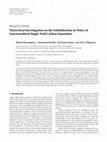
Journal of Nanotechnology, 2012
An important technique to increase the solubility and reactivity of carbon nanotube is through fu... more An important technique to increase the solubility and reactivity of carbon nanotube is through functionalization. In this study, the effects of functionalization of some single-walled carbon nanotubes (SWCNTs) were investigated with the aid of density functional theory. The SWCNT model used in the study consists of a finite, (5, 0) zigzag nanotube segment containing 60 C atoms with hydrogen atoms added to the dangling bonds of the perimeter carbons. There are three water-dispersible SWCNTs used in this study that were functionalized with (a) formic acid, as a model of carboxylic acid, (b) isophthalic acid, as a model aromatic dicarboxylic acid, and (c) benzenesulfonic acid, as a model aromatic sulfonic acid. Binding energies of the organic radicals to the nanotubes are calculated, as well as the HOMO-LUMO gaps and dipole moments of both nanotubes and functionalized nanotubes. Binding was found out to be thermodynamically favorable. The functionalization increases the electrical dipole moments and results in an enhancement in the solubility of the nanotubes in water manifested through favorable changes in the free energies of solvation. This should lower the toxicity of nanotubes and improve their biocompatibility.
Meeting abstracts of the Physical Society of Japan, Mar 4, 2006
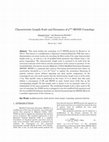
arXiv (Cornell University), Jul 27, 2023
This work studies the cosmology of χ 3/2-MOND gravity by Bernal et. al. (2011). This theory is a ... more This work studies the cosmology of χ 3/2-MOND gravity by Bernal et. al. (2011). This theory is a modification to Einstein's General Relativity (GR) that uses a dimensionless curvature scalar χ by rescaling the Ricci scalar by some characteristic length scale , as well as a set of modified field equations that follows from a 3/2power Lagrangian. The characteristic length scale is assumed to be built from the universal constants of the theory and the parameters of the system in question. In the weak field limit, this theory recovers Milgrom's (1983a) Modified Newtonian Dynamics (MOND). MOND is a proposal that corrects Newtonian gravitational laws below an acceleration threshold 0 ≈ 1.2 × 10 −10 / 2 to explain the anomalous flattening of galactic rotation curves without imposing any dark matter components. In the cosmological case, this work asserts that the characteristic length scale is of the order 2 / 0. This specific value is motivated in two ways: (1) it is shown that this scale defines a convergence of GR and MOND at some critical mass (with this as the corresponding length); (2) this length scale is shown to be an extremal value of independent of the mass parameter. The established length scale is then used in the case of cosmology; the FLRW metric is plugged in into the modified field equations and the two modified Friedmann equations are derived incorporating the MOND effects by a manifest appearance of the constant 0 .
Meeting Abstracts of the Physical Society of Japan (Nihon Butsuri Gakkai koen gaiyoshu), 2006
In this paper, we calculated the weak deflection angle of a dirty Schwarzschild black hole of mas... more In this paper, we calculated the weak deflection angle of a dirty Schwarzschild black hole of mass m by considering finite-distance correction. The astrophysical environment considered in this study is a spherical shell of dark matter, which is only described by its mass M and some physical parameters. We found out that for notable deviations in the weak deflection angle to occur, the effective radius of the dark matter distribution must be in the order of ∼6√(mM), which only happens if the dark matter density is very high near a black hole. This makes the weak deflection angle a preferable method in detecting dark matter near a black hole than using the deviations in the shadow radius which only occurs when Δ r_s∼√(3mM).
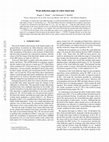
Chinese Journal of Physics, 2020
In this paper, we present the weak deflection angle in a Schwarzschild black hole of mass m surro... more In this paper, we present the weak deflection angle in a Schwarzschild black hole of mass m surrounded by the dark matter of mass M and thickness ∆rs. The Gauss-Bonnet theorem, formulated for asymptotic spacetimes, is found to be ill-behaved in the third-order of 1/∆rs for very large ∆rs. Using the finite-distance for the radial locations of the source and the receiver, we derived the expression for the weak deflection angle up to the third-order of 1/∆rs using Ishihara (et al.) method. The result showed that the required dark matter thickness is ∼ 2 √ 3mM for the deviations in the weak deflection angle to occur. Such thickness requirement is better by a factor of 2 as compared to the deviations in the shadow radius (∼ √ 3mM). It implies that the use of the weak deflection angle in detecting dark matter effects in one's galaxy is better than using any deviations in the shadow radius.

Korean Journal of Materials Research, 2016
In this work, recent progress on graphene/metal oxide composites as advanced materials for and ca... more In this work, recent progress on graphene/metal oxide composites as advanced materials for and capture was investigated. Density Functional Theory calculations were used to understand the effects of temperature on the adsorption ability of and water vapor on adsorption on CaO (001) with reinforced carbon-based nanostructures using B3LYP functional. Understanding the mechanism by which mercury and adsorb on graphene/CaO (g-CaO) is crucial to the design and fabrication of effective capture technologies. The results obtained from the optimized geometries and frequencies of the proposed cluster site structures predicted that with respect to molecular binding the system possesses unusually large ( sorbent) and ( sorbent) uptake capacities. The and were found to be stable on the surface as a result of the topology and a strong interaction with the g-CaO system; these results strongly suggest the potential of CaO-doped carbon materials for and capture applications, the functional gives reliable answers compared to available experimental data.
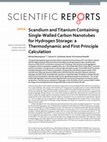
Scientific reports, Jun 15, 2016
The generalized gradient approximation (GGA) to density functional theory (DFT) calculations indi... more The generalized gradient approximation (GGA) to density functional theory (DFT) calculations indicate that the highly localized states derived from the defects of nitrogen doped carbon nanotube with divacancy (4ND-CNxNT) contribute to strong Sc and Ti bindings, which prevent metal aggregation. Comparison of the H2 adsorption capability of Sc over Ti-decorated 4ND-CNxNT shows that Ti cannot be used for reversible H2 storage due to its inherent high adsorption energy. The Sc/4ND-CNxNT possesses favorable adsorption and consecutive adsorption energy at the local-density approximation (LDA) and GGA level. Molecular dynamics (MD) study confirmed that the interaction between molecular hydrogen and 4ND-CNxNT decorated with scandium is indeed favorable. Simulations indicate that the total amount of adsorption is directly related to the operating temperature and pressure. The number of absorbed hydrogen molecules almost logarithmically increases as the pressure increases at a given temperatu...
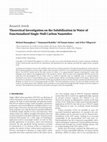
Journal of Nanotechnology, 2012
An important technique to increase the solubility and reactivity of carbon nanotube is through fu... more An important technique to increase the solubility and reactivity of carbon nanotube is through functionalization. In this study, the effects of functionalization of some single-walled carbon nanotubes (SWCNTs) were investigated with the aid of density functional theory. The SWCNT model used in the study consists of a finite, (5, 0) zigzag nanotube segment containing 60 C atoms with hydrogen atoms added to the dangling bonds of the perimeter carbons. There are three water-dispersible SWCNTs used in this study that were functionalized with (a) formic acid, as a model of carboxylic acid, (b) isophthalic acid, as a model aromatic dicarboxylic acid, and (c) benzenesulfonic acid, as a model aromatic sulfonic acid. Binding energies of the organic radicals to the nanotubes are calculated, as well as the HOMO-LUMO gaps and dipole moments of both nanotubes and functionalized nanotubes. Binding was found out to be thermodynamically favorable. The functionalization increases the electrical dipo...
Shinku, 2006
We investigate the catalytic property of the intermetallic compound Pt 3 Ti by studying the inter... more We investigate the catalytic property of the intermetallic compound Pt 3 Ti by studying the interaction of its (111) surface with hydrogen. Based on density functional theory, we obtain the 2-D PES to estimate the barrier for H 2 dissociation, and the binding energy of H atom at diŠerent sites of the substrate. The observed energetics can be explained in terms of the role played by the Ti atoms in the compound. Our results show that the Ti atoms function as inactive components that dilute the concentration of the active Pt components thus making the compound less active than Pt towards hydrogen.
International Journal of Modern Physics A, 1999
We exhibit the one-loop multigluon effective Lagrangian in any dimension for a field theory with ... more We exhibit the one-loop multigluon effective Lagrangian in any dimension for a field theory with a quasilocal background, using the background-field formalism. Specific results, including counterterms (up to 12 space–time dimensions), have been derived, applied to the Yang–Mills theory and found to be in agreement with other string-inspired approaches.
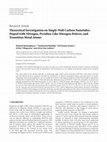
Journal of Nanomaterials, 2012
This study addresses the inherent difficulty in synthesizing single-walled carbon nanotubes (SWCN... more This study addresses the inherent difficulty in synthesizing single-walled carbon nanotubes (SWCNTs) with uniform chirality and well-defined electronic properties through the introduction of dopants, topological defects, and intercalation of metals. Depending on the desired application, one can modify the electronic and magnetic properties of SWCNTs through an appropriate introduction of imperfections. This scheme broadens the application areas of SWCNTs. Under this motivation, we present our ongoing investigations of the following models: (i) (10, 0) and (5, 5) SWCNT doped with nitrogen (CNxNT), (ii) (10, 0) and (5, 5) SWCNT with pyridine-like defects (3NV-CNxNT), (iii) (10, 0) SWCNT with porphyrine-like defects (4ND-CNxNT). Models (ii) and (iii) were chemically functionalized with 14 transition metals (TMs): Sc, Ti, V, Cr, Mn, Fe, Co, Ni, Cu, Zn, Pd, Ag, Pt and Au. Using the spin-unrestricted density functional theory (DFT), stable configurations, deformations, formation and bindi...
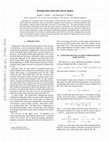
In this paper, we examine the effect of dark matter to a Kerr black hole of mass m. The metric is... more In this paper, we examine the effect of dark matter to a Kerr black hole of mass m. The metric is derived using the Newman-Janis algorithm, where the seed metric originates from the metric of a Schwarzschild black hole surrounded by a spherical shell of dark matter with mass M and thickness Δ r_s. We analyzed both the time-like and null geodesics and found out that if the dark matter density is considerably low, time-like geodesics shows more deviations from the Kerr case compared to null geodesics. Furthermore, energy extraction via the Penrose process remains unchanged. A high concentration of dark matter near the rotating black hole is needed to have considerable deviations on the horizons and photonsphere radius. With the dark matter configuration used in this study, we found that deriving an analytic estimate to determine the condition for dark matter to have a notable change in the shadow radius is inconvenient.

TO BE MODIFIED.In a single loop RL circuit, with a DC voltage source, the current is constant. Th... more TO BE MODIFIED.In a single loop RL circuit, with a DC voltage source, the current is constant. The inductor in a circuit produce aback emf which creates a reverse current. This back-emf prevents the current in reaching the load hence, there isno voltage across the load. This reverse current can be described by a first order time dependent differential equationwhich shows the gradual increase of reverse current as the magnetic field in the inductor approaches to maximum.But the theoretical and practical results vary by some degrees due to some systematic errors. To compensate thiserror and to determine the numerical result with high precision and accuracy, the equation of reverse current issolved in fractional differential equation form. This paper focusses on deriving the fractional representation of thecurrent growth and current decay in a RL Circuit. The authors used the fractional differential equation and fractionalorder Laplace transform to derive the solution. Simulation of th...

In this paper, we discussed the possible effects of dark matter on a Schwarzschild black hole wit... more In this paper, we discussed the possible effects of dark matter on a Schwarzschild black hole with extended uncertainty principle (EUP) correction such as the parameter α and the large fundamental length scale L∗. In particular, we surrounded the EUP black hole of mass m with a static spherical shell of dark matter described by the parameters mass M , inner radius rs, and thickness ∆rs. Considering only the case where the EUP event horizon coincides rs, the study finds that there is no deviation in the event horizon, which readily implies that the black hole temperature due to the Hawking radiation is independent of any dark matter concentration. In addition, we explored the deviations in the innermost stable circular orbit (ISCO) radius of time-like particles, photonsphere, shadow radius, and weak deflection angle. It is found that time-like orbits are sensitive to deviation even for low values of mass M. A greater dark matter density is needed to have considerable deviations to nu...








Uploads
Papers by Emmanuel T Rodulfo
1 De La Salle University-Manila, Solid State Physics Laboratory
2401 Taft Ave. Manila, 1004 Philippines
*corresponding author: emmanuel.rodulfo@dlsu.edu.ph
ABSTRACT: The role of the observer in physics is reconsidered in connection with our evolving assumptions about the nature of time. Unlike the observer’s optional movement through space, evolution in time is compulsory and strictly governed by causal order. Thus, it is argued that time is intrinsically more fundamental than space. The geometry of space is appreciated as an emergent degrees of freedom which allows moving observers to develop invariant transformation equations. Inertial laws are shown to emerge from the observer’s assumptions about the nature of time and its transformations. We are thus led to explore the next logical extension of the observer’s progressing appreciation of the nature of time by allowing time to depend on higher-derivative kinematical quantities. This leads to inertial laws that may potentially accommodate various nonlinear phenomena such as the yet unresolved celestial anomalies, and possibly provide the needed degrees of freedom for the unification of classical with quantum theory.
Keywords: observer, emergent manifold, causality, time dilation, relativity of time, higher-derivative theories, modified inertia, alternative gravity theory
De La Salle University, 2401 Taft Avenue, Malate, Manila, Philippines
Presented at the Philippine Economic Zone Authority (PEZA) From Paris Agreement to PEZA Commitment: Promoting a UNFCCC-Conscious Ecozone Development Planning in celebration of the World Environment Day on 5th and 6th day of June, 2017 at the PEZA Social Hall of the PEZA Head Office, Bonifacio Global City 1634 Metro Manila, Philippines
ABSTRACT: This review aims to provide a broader perspective to the current interest on climate variability by revisiting the astrophysical mechanisms that dictate our planet’s climate cycles. The intrinsic variability of the sun’s power output is indisputably a dominant contributor to global temperature as its irradiance pulsates roughly every ~10.7 years, modulated by a longer quasi periodic ~186-year cycle manifested by the Oort, Wolf, Sporer, Maunder; and Dalton solar minima. The Little Ice Age (1350-1850) was purportedly triggered by the five-decade-long Maunder Minimum (1645-1715). Quite apart from this intrinsic variability of the sun, the Milanković hypothesis attributes the amount of incoming solar radiation (insolation) to Earth’s spin-orbit dynamics. The superposition of the ~100ka oscillation in the planet’s orbital eccentricity, the ~22ka apsidal precession, and the ~41ka oscillation of axial obliquity, has been known to correlate with the time-rate of change of global temperature, which appear to explain the alternating sequence of glacial and interglacial epochs (1ka=1000y). The current interglacial period (the Holocene) has already idled for more than a millennium beyond the mean duration. In order to provide a quantitative connection between insolation and the astrophysical drivers, we describe a streamlined model that allows one to calculate insolation as a function of the the varying solar output and Milanković parameters. Through this quasi-theoretical review, we hope to shed some light on the uncertainties that currently plague climate science.
Keywords: Global warming, climate change, solar variability, sunspot number, solar irradiance, insolation, Milanković cycles, obliquity, eccentricity, apsidal precession, celestial dynamics, Kepler’s Laws, orbit equation, classical perturbation theory, Maunder Minimum, Dalton Minimum, Little Ice Age
1Physics Department, De La Salle University, 2401 Taft Ave. Manila, 0922 Philippines
*Corresponding author: emmanuel.rodulfo@dlsu.edu.ph
ABSTRACT: A certain amount of time after the implementation of intervention to control an outbreak, a kink develops in the epidemic curve. These discontinuities in the gradient of the curve should be treated as observables as they confirm the effectiveness of interventions that began in the past. As a retarded response time of an epidemic to intervention, this may be used to parametrize the effectiveness of the intervention in flattening the curve. To construct a model that recognizes how this kink heralds the flattening of the curve, we draw upon the qualitative features of the S-ℑ-ℜ model, but in recognition of the role of the kink, we forego smoothness of the curve at this transitional stage. With these in mind, we formulate an analytic expression for the fraction of the population infected by a contagious disease spreading according to some power law, and responsive to a delayed intervention. Up to the time when the effect of the intervention manifests, instead of using the conventional exponentially increasing function known to over-estimate the data, the outbreak is modeled by a real power function which more closely describes the accelerated stage of epidemics. The moment the intervention takes effect, a decaying exponential function with a characteristic time defined by the viral power and the time of the appearance of the kink is introduced to flatten the power curve. The model provides a calculation for the peak of the epidemic as well as the inflection times when rate of change in the number of infectives is extremum. The recent Philippine May 23, 2020 data on COVID-19 pandemic is used in sample calculations.
Key words: epidemiology, epidemic curve, exponential growth and decay, sub-exponential growth, power function, S-ℑ-ℜ model, gamma/factorial function, binomial expansion, critical points, stationary points, curvature, concavity, inflection points, kink, COVID-19, incubation period, recovery period, social/physical distancing, community quarantines